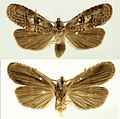GLAM/Newsletter/June 2014/Contents/Open Access report
|
Open biodiversity data; Automated import of scholarly journal articles into Wikisource
Biodiversity research goes open data
In a move inspired by the Bermuda Principles on open data in human genomics and by the Budapest, Bethesda and Berlin declarations on Open Access, natural history museums, botanical gardens and other institutions engaged in biodiversity research have launched and signed a declaration on open data. As the launch took place in the Bouchout Castle in the Botanical Garden of Meise (Belgium), the declaration is named the Bouchout declaration. More details in the Belgium report.
Automated import of scholarly articles into the English Wikisource
A proposal has been made on the English Wikisource to import the full text of suitably licensed scholarly articles in a bot-assisted fashion, with the corresponding media files going into Wikimedia Commons. The bot code exists and has been tested on 10 sample articles.
Open Access Media Importer
The following represents a selection of the ca. 300 files that have been uploaded by the Open Access Media Importer this month, bringing the total to over 16,800. If you can think of wiki pages where these files could be useful, please put them in there or let us know.
Open Access File of the Day
The following files have been featured as Open Access File of the Day this month:
-
June 31: histopathology slide of chordoma
-
June 30: activation of brain's reward system
-
June 29: the beetle Tecnophilus croceicollis
-
June 28: Laserpitium ochridanum, named after Laserwort from antiquity
-
June 27: The frog Platymantis pygmaeus.
-
June 26: the moth Exelastis caroli
-
June 25: Spatial relationship between Müller cells and microglia
-
June 26: edmontosaur skulls
-
June 23: the blenny Haptoclinus dropi
-
June 22: a prehistoric snakefly, Styporaphidia hispanica
-
June 21: shell of the land snail Streptostele musaecola
-
June 20: The fish Praealticus labrovittatus jumping.
-
June 19: the bee Epicharis umbraculata
-
June 18: the beetle Scybalocanthon korasakiae
-
June 17: the frog Fejervarya moodiei
-
June 16: male of moth Dunama jessiehillae
-
June 15: brain with DiGeorge syndrome
-
June 14: ants, Camponotus leonardi
-
June 13: guard cells in plant stoma
-
June 11: the sea snail Micromelo undata
-
June 10: The forget-me-not Alkanna noneiformis.
-
June 9: skeletal reconstruction of the dinosaur Sanjuansaurus gordilloi
-
June 8: the beetle Plectromerus roncaevi
-
June 7: an eye affected by Wolfram syndrome
-
June 6: shell of the freshwater snail Pomacea haustrum
-
June 5: The snake Cyclocorus lineatus.
-
June 4: the bellflower Edraianthus horvatii
-
June 3: the common bleak Alburnus alburnus
-
June 2: skull of Lepidochelys kempii, a sea turtle
-
June 1: nurse cells develop the oocyte
| Home | About | Archives | Subscribe | Suggestions | Newsroom |



























